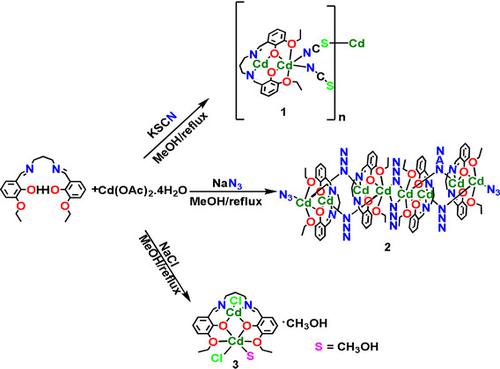当前位置:
X-MOL 学术
›
ChemistrySelect
›
论文详情
Our official English website, www.x-mol.net, welcomes your feedback! (Note: you will need to create a separate account there.)
Cd(II) Pseudohalide Complexes with N, N′‐Bis(3‐ethoxysalicylidenimino) 1,3‐Diaminopropane: Crystal Structures, Hirshfeld Surface, Antibacterial and Anti‐Biofilm Properties
ChemistrySelect ( IF 2.1 ) Pub Date : 2018-03-15 , DOI: 10.1002/slct.201702970 Dhrubajyoti Majumdar 1 , Jayanta Kumar Biswas 2 , Monojit Mondal 2 , Manabolu Surya Surendra Babu 3 , Sourav Das 4 , Ramesh K. Metre 5 , Sreejith S. SreeKumar 6 , Kalipada Bankura 1 , Dipankar Mishra 1
ChemistrySelect ( IF 2.1 ) Pub Date : 2018-03-15 , DOI: 10.1002/slct.201702970 Dhrubajyoti Majumdar 1 , Jayanta Kumar Biswas 2 , Monojit Mondal 2 , Manabolu Surya Surendra Babu 3 , Sourav Das 4 , Ramesh K. Metre 5 , Sreejith S. SreeKumar 6 , Kalipada Bankura 1 , Dipankar Mishra 1
Affiliation

|
Self‐assemblies of N2O4 donor Schiff base ligands, that is, N,N′‐Bis(3‐ethoxysalicylidenimino) 1, 3‐diaminopropane (H2LOEt) with cadmium acetate salts in presence of auxiliary co‐ligands thiocyanato/azido/chloride allow the formation of three anion control complexes, specifically, [Cd2LOEt(μ1,3‐SCN)(η1‐SCN)]n (1), {Cd4(LOEt)2(μ1,1‐N3)3(η1‐N3)]2 (2) and [Cd2(LOEt)(Cl)2.CH3OH].CH3OH] (3). Crystal structures of complexes 1–3 were determined by single‐crystal X‐ray diffraction studies. The single‐crystal X‐ray diffraction analysis confirmed that complex 1 is an one‐dimensional polymeric chain in which Cd(II) ions are bridged by one thiocyanate group bonding in an end‐to‐end fashion. Complex 2 is a centrosymmetric octanuclear complex with double end‐on azide (μ1,1‐N3−) as linker. On the other hand, 3 is a dinuclear complex with terminally bound Cl− ions. Analysis of the structure revealed that all the complexes possess a 4‐membered Cd2 (μ2‐O)2 core fastened by the combined coordination action of a doubly deprotonated ligand. Complexes 1–3 have been successfully characterized by elemental analyses, IR and UV‐Vis spectroscopy. The luminescent properties of complexes 1–3 have been studied in DMSO solution. The antibacterial and antibiofilm potential for complexes 1–3 were investigated against Gram‐positive and Gram‐negative bacterial strains. Intermolecular interactions with respect to percentages of hydrogen bonding of cadmium complexes were quantified by Hirshfeld surface.
中文翻译:

具有N,N'-双(3-乙氧基水杨基亚氨基)1,3-二氨基丙烷的Cd(II)拟卤化物配合物:晶体结构,Hirshfeld表面,抗菌和抗生物膜特性
N 2 O 4供体席夫碱配体,即N,N'-Bis(3-乙氧基水杨基亚氨基)1,3-二氨基丙烷(H 2 L OEt)与乙酸镉盐在辅助共配体硫氰酸根存在下的自组装/叠氮基/氯化物允许三个阴离子控制复合体的形成,具体地,[CD 2大号OET(μ 1,3 -SCN)(η 1 -SCN)] ñ(1),{镉4(L OET)2(μ 1,1 -N 3)3(η 1 -N3)] 2(2)和[Cd 2(L OEt)(Cl)2 .CH 3 OH] .CH 3 OH](3)。配合物1-3的晶体结构是通过单晶X射线衍射研究确定的。单晶X射线衍射分析证实,配合物1是一维聚合物链,其中Cd(II)离子通过一个硫氰酸酯基团以首尾相连的方式桥接。复杂2是中心对称octanuclear复合物与双端上的叠氮化物(μ 1,1 -N 3 - )作为连接器。另一方面,3是双核配合物与末端结合的氯-离子。结构的分析表明,所有的复合物具有一个4元镉2(μ 2 -O)2芯由一个双重去质子化的配体的组合的协调动作紧固。配合物1-3已通过元素分析,IR和UV-Vis光谱法成功表征。在DMSO溶液中已经研究了配合物1-3的发光特性。1-3复合物的抗菌和生物膜潜力对革兰氏阳性和革兰氏阴性细菌菌株进行了调查。相对于镉络合物氢键结合百分比的分子间相互作用通过Hirshfeld表面进行定量。
更新日期:2018-03-15
中文翻译:

具有N,N'-双(3-乙氧基水杨基亚氨基)1,3-二氨基丙烷的Cd(II)拟卤化物配合物:晶体结构,Hirshfeld表面,抗菌和抗生物膜特性
N 2 O 4供体席夫碱配体,即N,N'-Bis(3-乙氧基水杨基亚氨基)1,3-二氨基丙烷(H 2 L OEt)与乙酸镉盐在辅助共配体硫氰酸根存在下的自组装/叠氮基/氯化物允许三个阴离子控制复合体的形成,具体地,[CD 2大号OET(μ 1,3 -SCN)(η 1 -SCN)] ñ(1),{镉4(L OET)2(μ 1,1 -N 3)3(η 1 -N3)] 2(2)和[Cd 2(L OEt)(Cl)2 .CH 3 OH] .CH 3 OH](3)。配合物1-3的晶体结构是通过单晶X射线衍射研究确定的。单晶X射线衍射分析证实,配合物1是一维聚合物链,其中Cd(II)离子通过一个硫氰酸酯基团以首尾相连的方式桥接。复杂2是中心对称octanuclear复合物与双端上的叠氮化物(μ 1,1 -N 3 - )作为连接器。另一方面,3是双核配合物与末端结合的氯-离子。结构的分析表明,所有的复合物具有一个4元镉2(μ 2 -O)2芯由一个双重去质子化的配体的组合的协调动作紧固。配合物1-3已通过元素分析,IR和UV-Vis光谱法成功表征。在DMSO溶液中已经研究了配合物1-3的发光特性。1-3复合物的抗菌和生物膜潜力对革兰氏阳性和革兰氏阴性细菌菌株进行了调查。相对于镉络合物氢键结合百分比的分子间相互作用通过Hirshfeld表面进行定量。


























 京公网安备 11010802027423号
京公网安备 11010802027423号